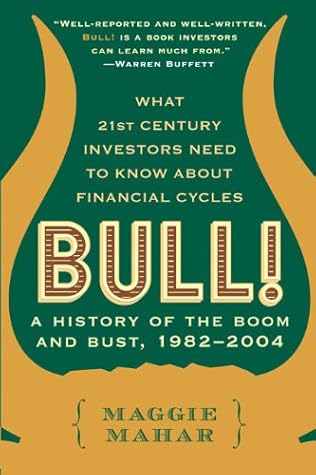More on this book
Kindle Notes & Highlights
by
Maggie Mahar
Read between
November 13 - November 16, 2020
1982–2004
Lays Down
The Mutual Fund Manager:
Abby Cohen
The 34-year-old Merrill Lynch analyst was accustomed to the pressures of his job.
In recent years, Wall Street firms had realized the importance of turning their analysts into brand names, and “Blodget” had become a brand. With just a few words, he could send a stock to the moon.
Amazon.com.
CIBC Oppenheimer
At the time, Amazon was trading at $240; within weeks, it blasted straight t...
This highlight has been truncated due to consecutive passage length restrictions.
February of 1999, Merrill offered Blodget a plum job—first chair on the firm’s Internet research team. Before long, the press would be speculating that, in 2001, Merrill Lynch paid Blodget as much as $12 million a year.
the $400 forecast,
between $150 and $500.
his firm’s sales team
But as his very first boss on Wall Street had told him, “You’re not a portfolio manager—you’re not trying to sneak quietly into a stock before someone else sees it. You’re an analyst: your job is to go out and take a position.”
So he said it—$400. And Amazon turned out to be a home run. His career had turned on that one call.
Prude...
This highlight has been truncated due to consecutive passage length restrictions.
Morgan Stanley’s Mar...
This highlight has been truncated due to consecutive passage length restrictions.
“Queen of th...
This highlight has been truncated due to consecutive passage length restrictions.
World Trade Center.
disgusted.
The money manager’s message was clear: We own the stock. We own you.
There were things worth dying for; stock picking was not one of them.
Institutional Investor rankings
Institutional Investor
And the bigger his name, the higher his pay.
the banking business,
Blodget understood that to Merrill’s Internet banking team, he was a key asset.
The New York Times
Silicon Valley c...
This highlight has been truncated due to consecutive passage length restrictions.
T...
This highlight has been truncated due to consecutive passage length restrictions.
Morgan Stanley’s shares
Times
Merrill Lynch,
Institutional Investor
institutional investors
And, you did not make a lot of friends if you downgraded the stocks they owned. Especially if...
This highlight has been truncated due to consecutive passage length restrictions.
The New York Times,
New York Attorney General Eliot Spitzer
But even if Henry Blodget had read Galbraith’s book in 2000, he might not have recognized the full relevance of Galbraith’s story. For as the Great Bull Market of 1982 to 1999 reached a climax, only a handful of the actors onstage were ready to acknowledge that the longest bull market in U.S. history was coming to a disastrous end.
—1— THE MARKET’S CYCLES
January 1975.
Richard Russell
Russell based his predictions on “Dow Theory,” an analysis of stock market cycles invented by William Peter Hamilton and Charles Dow.
Charles Dow
Gail Dudack,
SunGard Institutional Brokerage,
Finally, in 1982, the cycle turned: from January 1983 through December 1999, real returns averaged 12.1 percent. If an investor reinvested his dividends, he was rewarded with annual returns of 15.7 percent.
Grant’s Interest Rate Observer, put it in 1996,
THE LIMITS AND USES OF CYCLE THEORY—RUSSELL’S RECORD


